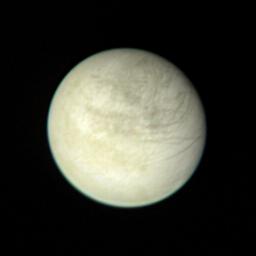
Europa
Europa, the second innermost of the Galilean moons, is 670,000 kilometers from Jupiter and is the smallest of the four. It is slightly smaller than Earth’s Moon and has a diameter of 3138 kilometers.
Europa is a very unique moon. It has an extremely smooth surface, with nothing exceeding one kilometer in height. There are also very few craters on Europa, and only three of them are larger than five kilometers in diameter. This indicates that Europa has a young surface (Arnett “Europa”). Although its true age is still in question, it is estimated to be as young as thirty million years old.
In addition to being the smoothest body in the solar system, it is also one of the whitest and the brightest, being five times brighter than Earth’s moon (Morgan “Europa”). Europa is also one of the few moons in our solar system that are known to have atmospheres. Its atmosphere is very thin and is composed of oxygen (Arnett “Europa”).
One of the most fascinating things about Europa is that it has more water, either frozen or liquid, than all the oceans on Earth combined. The same gravitational tides that make Io so unique may also keep a liquid water ocean beneath Europa’s icy surface from freezing. If this is true, there is a strong possibility that life may exist deep in the bowels of this interesting moon (Newcott 136).
